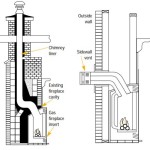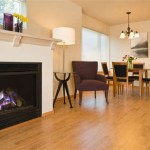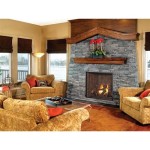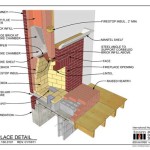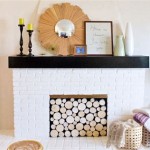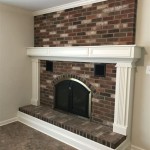Covering A Brick Fireplace: Methods, Materials, and Considerations
A brick fireplace can be a defining feature in a home, imparting a sense of tradition and warmth. However, its aesthetic appeal might not always align with prevailing design trends or evolving personal tastes. Covering a brick fireplace presents a renovation option that allows homeowners to update the look of their living space without the labor-intensive and costly process of complete fireplace removal. This article will explore various methods, materials, and considerations involved in covering a brick fireplace, offering a comprehensive guide for homeowners and contractors.
Assessing the Existing Fireplace
Prior to embarking on any covering project, a thorough assessment of the existing brick fireplace is crucial. This evaluation should encompass several factors, including the structural integrity of the brickwork, the fireplace's functionality, and any potential safety hazards. Cracks, crumbling mortar, or water damage can compromise the stability of the fireplace and should be addressed before any covering material is applied.
The functionality of the fireplace is another key consideration. If the fireplace is actively used, the covering material must be heat-resistant and non-combustible, adhering to local building codes and safety regulations. Many covering materials are designed for decorative purposes only and are not suitable for use with a functional fireplace. Furthermore, the existing fireplace may contain asbestos, particularly in older homes. If asbestos is suspected, professional testing and abatement are essential before any demolition or alteration work begins.
The size and dimensions of the fireplace also influence the choice of covering material and the complexity of the installation. A large, imposing fireplace may require more extensive modification and reinforcement than a smaller, more streamlined design. Finally, the surrounding architectural elements and the overall style of the room should be considered to ensure that the covered fireplace integrates seamlessly with the existing décor.
Methods for Covering a Brick Fireplace
Several methods can be employed to cover a brick fireplace, each offering distinct advantages and disadvantages in terms of cost, aesthetics, and ease of installation. These methods include:
Drywall: Drywall, also known as gypsum board, is a widely used and relatively inexpensive option for covering a brick fireplace. It provides a smooth, paintable surface that can be easily customized to match the surrounding walls. However, drywall is not inherently heat-resistant and requires careful insulation to prevent fire hazards. A gap should be left between the brick and the drywall to allow for expansion and contraction due to heat.
The installation process typically involves constructing a wooden or metal frame around the fireplace, attaching the drywall to the frame, and then taping, mudding, and sanding the seams to create a seamless finish. This method is well-suited for fireplaces that are no longer in use or that are primarily decorative.
Stone Veneer: Stone veneer offers a more substantial and visually appealing alternative to drywall. It consists of thin slices of natural or manufactured stone that are adhered to the brick surface using mortar. Stone veneer is available in a wide range of styles, colors, and textures, allowing homeowners to create a rustic, modern, or traditional look.
While stone veneer is more expensive than drywall, it provides superior durability and heat resistance, making it suitable for fireplaces that are occasionally used. The installation process requires careful planning and execution to ensure that the stones are properly aligned and securely bonded to the brick. A scratch coat may be required to promote adhesion to the brick surface. The weight of the stone veneer must also be considered; heavier stone may require additional structural support.
Tile: Tile is another versatile option for covering a brick fireplace, offering a wide array of design possibilities. Ceramic, porcelain, and natural stone tiles are all suitable for fireplace applications, provided that they are rated for high-temperature use. Tile is durable, easy to clean, and available in a vast range of colors, patterns, and sizes.
The installation process involves applying a thin-set mortar to the brick surface and then carefully positioning the tiles to create the desired pattern. Grout is then applied between the tiles to fill the gaps and create a waterproof seal. Tile is a particularly good choice for fireplaces that are frequently used, as it is resistant to heat, stains, and scratches.
Wood Paneling: Wood paneling can create a warm and inviting atmosphere around a fireplace. Various types of wood, such as reclaimed barn wood, shiplap, or decorative moldings, can be used to achieve different aesthetic effects. However, wood is combustible and must be installed with careful consideration for fire safety.
A significant air gap should be maintained between the brick and the wood paneling, and fireproof insulation may be required to protect the wood from excessive heat. Flame-retardant coatings can also be applied to the wood to reduce the risk of fire. Wood paneling is best suited for fireplaces that are primarily decorative or that are used infrequently.
Plaster: Plaster involves applying one or more coats of a plaster mixture to the brick surface to create a smooth, textured finish. Plaster can be tinted or painted to match the surrounding walls or to create a contrasting accent. It is a relatively inexpensive option that can be easily customized to achieve different aesthetic effects.
The installation process involves preparing the brick surface, applying a bonding agent, and then troweling the plaster onto the wall. Multiple coats may be required to achieve the desired thickness and smoothness. Plaster is not inherently heat-resistant and may require additional insulation for use with a functional fireplace.
Selecting Appropriate Materials
The selection of appropriate materials is paramount to the success and safety of any fireplace covering project. The chosen materials must be compatible with the existing brickwork, resistant to heat and moisture, and aesthetically pleasing. Key material considerations include:
Adhesives: The adhesive used to bond the covering material to the brick surface must be specifically designed for masonry applications. Thin-set mortar, construction adhesive, and epoxy resins are all suitable options, depending on the type of covering material and the condition of the brick. It is essential to follow the manufacturer's instructions carefully to ensure proper bonding and avoid premature failure.
Insulation: Insulation is crucial for fireplaces that are actively used, as it helps to protect the covering material from excessive heat and prevent fire hazards. Non-combustible insulation materials, such as mineral wool, fiberglass, or ceramic fiber blankets, should be used in areas where the covering material is exposed to direct heat. These materials are designed to withstand high temperatures and prevent the spread of flames.
Finishes: The finish applied to the covered fireplace should be both aesthetically pleasing and durable. Paint, stain, sealant, and grout are all examples of finishes that can be used to protect and enhance the appearance of the covering material. It is important to choose finishes that are compatible with the covering material and that are specifically designed for fireplace applications. These finishes should be resistant to heat, moisture, and stains.
Framing Materials: When using drywall or other lightweight covering materials, framing may be necessary to provide a stable support structure. Wood or metal studs can be used to create a framework around the fireplace, to which the covering material is attached. The framing should be securely anchored to the surrounding walls and floor to ensure that it can support the weight of the covering material.
Safety Equipment: Personal protective equipment (PPE) is essential for all fireplace covering projects. Safety glasses, gloves, dust masks, and respirators should be worn to protect against dust, debris, and hazardous materials. Proper ventilation is also important, especially when working with adhesives, paints, or other chemicals.
Installation Best Practices
Proper installation is critical to ensuring the longevity, safety, and aesthetic appeal of a covered brick fireplace. Following these best practices will contribute to a successful project:
Surface Preparation: Thoroughly clean the brick surface to remove any dirt, dust, grease, or loose mortar. A wire brush, pressure washer, or chemical cleaner can be used to prepare the surface. Patch any cracks or holes in the brick with mortar or patching compound. A clean, sound surface is essential for proper adhesion of the covering material.
Accurate Measurements: Take accurate measurements of the fireplace and the surrounding area to ensure that the covering material fits properly. Use a level and square to ensure that the installation is straight and even. Careful planning and accurate measurements will prevent costly mistakes and ensure a professional finish.
Proper Bonding: Apply the adhesive according to the manufacturer's instructions. Use the appropriate amount of adhesive for the type of covering material and the condition of the brick. Ensure that the adhesive is evenly distributed and that the covering material is firmly pressed into place. Proper bonding is essential for preventing delamination and ensuring long-term durability.
Sealing and Finishing: Seal any gaps or cracks around the edges of the covering material with caulk or sealant. Apply paint, stain, or other finishes according to the manufacturer's instructions. Use multiple coats of finish to ensure adequate protection and a uniform appearance. Proper sealing and finishing will protect the covering material from moisture, stains, and damage.
Adherence to Building Codes: Comply with all local building codes and safety regulations. Consult with a qualified building inspector or contractor to ensure that the installation meets all applicable requirements. Failure to comply with building codes can result in fines, delays, and safety hazards.
Covering a brick fireplace is a viable option for updating a home's aesthetic. By carefully considering the existing fireplace's condition, choosing appropriate materials, and following proper installation techniques, homeowners can achieve a beautiful and functional fireplace that complements their living space.

How To Cover A Brick Fireplace With Wood Stone Nina Hendrick Home Remodel Diy

How To Cover A Brick Fireplace With Wood Stone Nina Hendrick Home

How To Plaster A Brick Fireplace So Much Better With Age
:max_bytes(150000):strip_icc()/MadetobeaMommaBefore-5bb2476446e0fb002607ad4f.jpg?strip=all)
Before And After Fireplace Makeovers

How To Cover A Brick Fireplace With Wood Stone Nina Hendrick Home

16 Red Brick Fireplace Makeover Ideas

Our Ugly Brick Fireplace He Vetoes Painting It Laurel Home

Diy Fireplace Makeover Wood Slat

How To Paint Your Brick Fireplace Katie Lamb

Fireplace Remodel Diy A Facade To Cover An Old Brick Without Painting The Build
Related Posts

